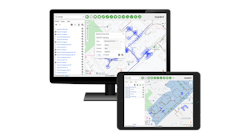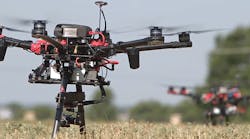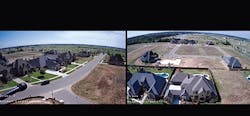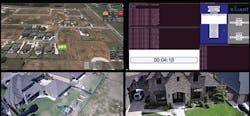Case Study: Mapping Revenues to Network Connectivity —
The telecom industry is changing at a rapid pace, with new challenges such as increasing competition due to lagging industry consolidation and revenues lost to new players. To stay relevant in the coming years, telecom providers need to modernize their businesses, and that means making some significant changes.
To meet current and future challenges, according to Strategy&, a PwC company, telecom providers should "… work on adopting one or more new strategic identities that are relevant to customers, offering them distinctive services and experiences with real value." That means expanding current offerings to reach new segments, and helping current customers meet their goals by capitalizing on innovative technologies.
With diverse applications and platforms such as machine-to-machine communications, unmanned ground vehicles and unmanned aerial vehicles (UGVs/UAVs), and Internet of Things devices expanding in usage, network operators may need to upgrade their infrastructures to handle the higher bandwidth these technologies require. According to Strategy&, "A further strategic opportunity for telecom companies lies in revenue streams keyed to connectivity, a particularly favorable option once companies have upgraded their networks, so they can handle even the most sophisticated applications … The customer base for these services is wide and potentially lucrative: utilities, industrial supply chains, smart homes, smart cities, and cybersecurity providers, among many others."
Case in point: when an Oklahoma-based security and alarm monitoring company decided to move beyond a traditional approach to security, and explored using drones to create a proactive approach to surveillance, it needed to find a mission-critical network technology to support it.
Old-School Security, New-School Tech
AlarmTransfer, based in Norman, Oklahoma, integrates next-generation security and surveillance technologies into standard practices for both residential and business customers, with an important part of its business model based on taking immediate action, enabled by its technology and network. If a customer’s home is being broken into, using pre-installed video and audio tools connected to a network, the team can get eyes on the intruder immediately, and announce over a loudspeaker that the police are on the way and the intruder is on camera.
Rajant’s wireless mesh network, including radios and networking technology, provides the communications backbone between drones in the field and a command center.
Simultaneously, the central monitoring station contacts people on a call list according to hierarchy (to ensure it is not a false alarm and that people within homes or businesses are safe), and then dispatches the police. This immediate intervention not only collects the video data that is useful in police investigations, but also has the potential to change the outcome of the event by getting the intruder to leave immediately without taking any possessions or harming the homeowner.
The company already uses a number of cutting-edge technologies to run its service offerings, but in early 2017, it began to look to the next frontier: drones.
A Network Made for Drones
The security firm began exploring the idea of using unmanned aerial vehicles (UAVs, or drones) in early 2017, and searched for a communications partner that would help the company build out a campus-area network capable of facilitating the drone operation its leadership envisioned.
There is an open link between the drone’s feed and the command center, so operators can view the scene and take remote control as needed.
This new initiative required a stable, high-speed network capable of streaming live video and audio footage from a remote location to the command center. It also needed to extend its capabilities to cover a larger geographic area, giving the company the ability to dispatch drones to provide a deeper level of situational awareness for law enforcement.
After exploring several options, an InstaMesh technology was chosen for the application. This three-dimensional wireless mesh technology by Rajant Corp., performs real-time evaluation and directs traffic via the fastest pathways between any wired, wireless, and in-motion points, to build out a mobile wireless network in the created zone of coverage. The network provides the communications backbone between the company’s drones in the field and the command center. Thus, it allows true real-time streaming of video and voice data.
"Most competitors in this space don’t have the technology that allows for that real-time streaming capability, instead relying on drones with local storage that can capture video but must return to a base and dock before the video can be uploaded and analyzed," said Lee Stauss, CEO of AlarmTransfer. "By the time that happens, you’ve lost the ability to effect some kind of change as action is taking place."
How a Security Surveillance Drone System Works
In this application, drones are stationed in a neighborhood, powered on and ready to roll out. When a customer’s alarm or alert is triggered, the command center’s network sends relevant data about the event (e.g., GPS coordinates, type of event if known) to the drone before it is deployed. Computer logic dictates flight path and the type of a drone responding (e.g., sending a drone with a thermal camera for a fire event).
Computer logic dictates flight path and the type of a drone responding (e.g., sending a drone with a thermal camera for a fire event).
The drone flies along a predetermined route to investigate. There is an open link between the drone’s feed and the command center, so operators can view the scene and take remote control as needed. Operators are Federal-Aviation-Administration-licensed drone pilots who perform the investigation at the event site and supplement the information that the central monitoring station — a separate facility from the drone command center — provides to law enforcement. Once the investigation is complete, the drone returns to its origin point and waits for the next mission.
Traditionally, response time for an alarm trigger can take up to several minutes, but some drones can fly to the scene in 30 seconds to a minute. This gets eyes immediately on the scene to provide a greater level of awareness of what is happening. The speed at which the drones can arrive at a scene potentially allows them to "see" the event as it unfolds, capturing live footage of the perpetrator(s) by flying exactly where it needs to get the best images. This provides law enforcement with more information than they would get normally, increasing the odds that law enforcement can apprehend a suspect quickly. Instead of saturating an area or perimeter with cameras, the drones create a streaming platform that takes cameras wherever they need to go.
When a customer’s alarm or alert is triggered, the command center’s network sends relevant data about the event (e.g., GPS coordinates, type of event if known) to the drone before it is deployed.
Additionally, this early intervention reduces false calls for service. If the drone arrives and sees that the alarm was triggered accidentally, the drone pilot can immediately alert the central monitoring station and the police that there is no need to send ground support. This conserves police resources for real events and decreases department overhead, and also can save customers from being charged for false alarms.
Soon, these drones may be able to live in "nests," or autonomous recharging units, located within a certain geographic radius. Creating a nest will achieve full autonomy for drones, but it requires precision landing, auto-charging, and protective cover of some kind, and many companies are investigating ways to economically create this.
Future Possibilities
Protecting residential communities and businesses are just a couple of applications for this type of aerial surveillance system. Agricultural, solar, and wind farms; border security; manufacturing enterprises; event management, and more; all can benefit from aerial surveillance technology powered by a high-bandwidth, low-latency network. This case study is just one example of a customer that needed additional network support in order to meet its goals, but a multitude of businesses will soon require ironclad network infrastructure to support the new technologies and applications that are becoming more mainstream in every facet of life.
By understanding and capitalizing on the changing needs of customers that will arise as technology continues to evolve and new applications become conventional, telecom providers can stay relevant, and successful, in both the near and distant future.
Resource
Strategy&. 2017 Telecommunications Trends. By Bahjat el-Darwiche, Pierre Peladeau, Chrstine Rupp, and Florian Groene. For more information and to download the report, please visit https://www.strategyand.pwc.com/trend/2017-telecommunications-industry-trends.









